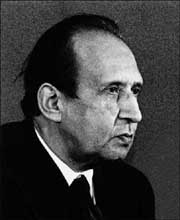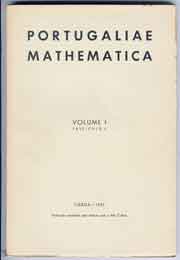|
Between Oporto and Recife
OUTSTANDING MATHEMATICIAN, RESISTANT, PROFESSOR IN BRAZIL, CANDIDATE TO THE PRESIDENCY OF THE REPUBLIC, HEAD OF THE UNIVERSITY OF OPORTO
Ruy Luís Gomes was born in Oporto on 5 December 1905 and died there on 28 October 1984. Throughout the almost 79 years of his life, he produced a vast number of mathematical works, tutored innumerable disciples, taught at various universities and suffered the political persecution of a regime that did not tolerate independent thinking. His life, just like that of countless other Portuguese intellectuals of that time, reveals the drama of the aborted birth of research in Portugal.
 |
|
|
|
|
Son of António Luís Gomes, a politician of the first republic, the young Ruy dedicated himself to study very early in life, where he revealed an extraordinary capacity for abstract reasoning. He graduated in mathematics from the University of Coimbra, where he concluded his PhD shortly afterwards in 1928, at the age of 22. In his PhD he analysed problems of mechanics, an area originating in the physical study of systems subject to forces, but which gained great autonomous mathematical development. He moved to the University of Oporto, where he started as Assistant Professor of Higher Algebra and Projective Geometry, followed by Physics and Mathematics. In 1933, at the age of 28, he reached the position of full professorship.
Those who had him as a teacher remember “a quite different form of teaching”, as José Morgado, his disciple and later colleague and friend, recalls: “instead of those apparently sure, free from hesitancy lectures”, you could attend classes that were “apparently not so sure, at times full of hesitations, yet […] lively, open to discussion, humanised and enthusiastic” where pupils felt they “participated, to a greater or lesser extent, in the growth or betterment of one or other aspect of the mathematical theories presented”. Only someone who participated in scientific research could teach in such a way. For Ruy Luís Gomes, teaching and research were undissociated activities of his academic work.
In the thirties and forties, the mathematician from Oporto kept up with the developments in the Physics and Mathematics area, contributing with numerous original works to these developments. At the same time, he corresponded with great mathematicians from other countries, such as the Italian Tullio Levi-Civita (1873–1941), earning references from other important figures of that period, such as winner of the Nobel award for Physics, Louis de Broglie (1892–1987), and the mathematician John von Neumann (1903–1957). He published several works in international magazines — “Rendiconti della Reale Accademia dei Lincei” and “Journal de Physique et Radio”.
At the time, a generation of brilliant and enthusiastic youth mathematicians arose in Portugal, namely António Aniceto Monteiro (1907–1980), Hugo Baptista Ribeiro (1910–1988) and José Sebastião e Silva (1914–1972). With the support of Gomes Teixeira (1851–1933), Mira Fernandes (1884–1958) and other mathematicians from previous generations, these men established connections with international research bodies and started to transmit their enthusiasm for modern mathematics and research to the students. It seemed as if the Portuguese universities were about to overcome the lethargy which, with some exceptions, had become established in teaching and research.
One of the ideas which this generation tried to instil in the country was that of a systematic connection between teaching and research, with teachers no longer being seen as mere transmitters of the theory acquired through foreign compendiums but rather as active research agents. The major concern of Ruy Luís Gomes and his companions was that Portuguese mathematicians become partners in the international effort for the progress of science. Another innovative idea of this generation was that of collective work in mathematics, promoted through seminars for the exchange of ideas, conferences, short courses, study and research centres and scientific societies.
The collective effort of the new mathematicians led to the creation of the magazines “Portugaliae Mathematica”, which appeared in 1937 and was dedicated to research articles, and “Gazeta Matemática”, launched in 1939 and dedicated to the dissemination of this subject. Despite some interruptions and major difficulties, both of these publications continue to be published today by the Portuguese Mathematical Society. The dynamic of this generation further led to the creation of the Mathematics, Physics and Chemistry Nucleus and the Mathematics Seminar in Lisbon. Still in Lisbon, under the impetus of Bento Jesus Caraça (1901–1948), Mira Fernandes and Beirão da Veiga, the Centre of Mathematical Studies Applied to Economics was created (later transformed into CEMAPRE – Centre of Mathematics Applied to Economic Forecast and Decision) within the Institute of Economic and Financial Sciences, currently ISEG – Higher Institute of Economics and Management.
In Oporto, Ruy Luís Gomes created the Centre of Mathematical Studies in 1942, where he promoted research seminars and trained young mathematicians. At the same time, he produced essays of great quality where he systematised various aspects of mathematics and modern physics and mathematics. In 1938, he published the work “Teoria da Relatividade Restrita” and in 1954 “A Teoria da Relatividade — Espaço, Tempo, Gravitação”. In 1949 he launched “Integral de Riemann”, which he later complemented with “Integral de Riemann-Stieltjes” (1952) and “Sobre as Relações entre Integral de Riemann e Integral de Lebesgue” (1953).
|
 |
|
|
|
Ruy Luís Gomes was one of the founders of «Portugaliae Mathematica», the Portuguese research magazine currently published by the Portuguese Mathematics Society.
|
However, the enthusiasm of the promising new generation of Portuguese mathematicians was annihilated when the Salazar regime established itself in Portugal. After several persecutions, in 1947 the government expelled practically all of the new mathematicians from the universities. Sebastião e Silva was the only one with a PhD in that period who managed to stay in Portugal.
Between 1947, year in which he was expelled from the universty, and 1958, date on which he left the country, Ruy Luís Gomes was imprisoned several times by the political police, remaining a strong opposer of the regime. In 1951, he was candidate to the Presidency of the Republic through the National Democratic Movement, however he did not even go to the ballot box as the government changed the election law retroactively, thus preventing his candidateship. Life in Portugal for Ruy Luís Gomes had become particularly difficult in personal terms and impossible in scientific terms. In 1958, he left for the University of Bahia Blanca, in Argentina, and in 1960 he moved to Recife, where he became responsible for a new development of mathematical research.
In 1974, he returned to Portugal, where he was nominated Head of the University of Oporto, a position he kept until 1975, the year of his jubilee. In 1984, the man whom Levi-Civita had simply and accurately described as “an earnest genius” died in his hometown.
Nuno Crato
|
|
|